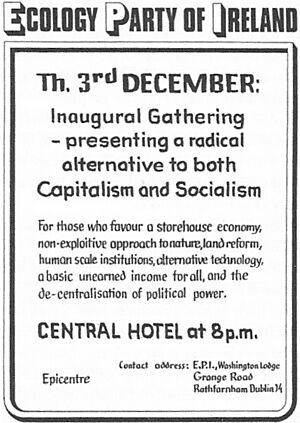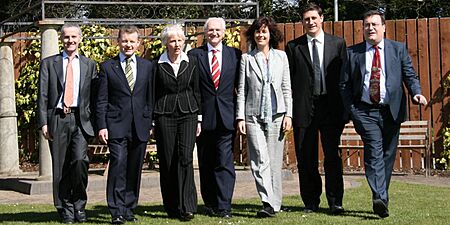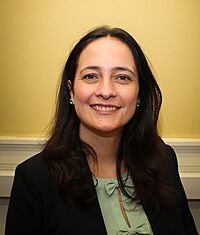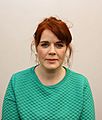Green Party (Ireland) facts for kids
Quick facts for kids <div style="padding-top:0.3em; padding-bottom:0.3em; border-top:2px solid Lua error in Module:European_and_national_party_data/config at line 227: attempt to index field 'data' (a nil value).; border-bottom:2px solid Lua error in Module:European_and_national_party_data/config at line 227: attempt to index field 'data' (a nil value).; line-height: 1;">
Green Party
Comhaontas Glas
|
|
|---|---|
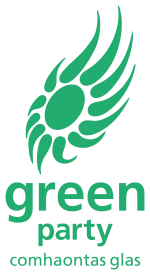 |
|
| Leader | Roderic O'Gorman |
| Deputy leader | Róisín Garvey |
| Northern Ireland leader | Mal O'Hara |
| Chairperson | Janet Horner |
| Founders |
|
| Founded | 3 December 1981 (as Ecology Party of Ireland) |
| Headquarters | 16–17 Suffolk Street, Dublin, Ireland |
| Youth wing | Young Greens |
| Membership (July 2024) | |
| Ideology | Green politics Pro-Europeanism |
| Political position | Centre-left |
| European affiliation | European Green Party |
| International affiliation | Global Greens |
| European Parliament group | Greens–European Free Alliance |
| Northern Ireland affiliate | Green Party Northern Ireland |
| Colours | Green |
| Dáil Éireann | Lua error in Module:European_and_national_party_data/config at line 227: attempt to index field 'data' (a nil value). |
| Seanad Éireann | Lua error in Module:European_and_national_party_data/config at line 227: attempt to index field 'data' (a nil value). |
| Local government in the Republic of Ireland |
23 / 949
|
| Local government in Northern Ireland |
5 / 462
|
| Website | |
| Lua error in Module:European_and_national_party_data/config at line 227: attempt to index field 'data' (a nil value). | |
The Green Party (in Irish: Comhaontas Glas) is a political party that works in both the Republic of Ireland and Northern Ireland. A political party is a group of people with similar ideas who work to get their members elected to government. The Green Party's main focus is on green issues, which means protecting the environment. It also supports being part of the European Union.
The party was started in 1981 by a Dublin teacher named Christopher Fettes. At first, it was called the Ecology Party of Ireland. It changed its name to the Green Alliance in 1983 and then to the Green Party in 1987.
Over the years, the Green Party has had members elected to local councils, the Dáil Éireann (Ireland's main house of parliament), the Northern Ireland Assembly, and the European Parliament. The party has been part of the Irish government two times. The first time was from 2007 to 2011, and the second was from 2020 to 2024.
After a tough election in 2011 where it lost all its seats in the Dáil, the party made a comeback. In the 2020 general election, it had its best result ever, winning 12 seats. However, in the 2024 election, it lost most of those seats, keeping only one.
Contents
History of the Green Party
The Green Party has a long history of growing from a small group into a major political force in Ireland.
How the Party Began
The party started as the Ecology Party in 1981. At their first press conference, they announced they would run in the 1982 general election. Only one journalist showed up! The party didn't win any seats and got a very small number of votes.
After changing its name to the Green Alliance, the party began to see more success. In 1985, Marcus Counihan became the first Green member elected to a town council.
In the 1989 election, the party, now called the Green Party, won its first seat in Dáil Éireann. Roger Garland was elected in the Dublin South area. Over the next decade, the party slowly grew. By the 2002 election, it had six members, known as TDs, in the Dáil.
First Time in Government (2007-2011)
After the 2007 election, the Green Party joined the government for the first time. They formed a coalition government with the Fianna Fáil party. This means they agreed to work together to run the country.
Being in government was a big step. John Gormley became the Minister for the Environment, and Eamon Ryan became the Minister for Communications, Energy and Natural Resources. They worked on new laws, like banning old-fashioned light bulbs and creating a tax system to encourage people to buy more eco-friendly cars.
However, this was a difficult time for Ireland because of a major banking crisis. The government had to make tough decisions, and many people were unhappy. The Green Party's support from voters dropped. In the 2011 election, the party lost all six of its Dáil seats.
Comeback and Second Time in Government
After losing all its seats, the party had to rebuild. Eamon Ryan was elected as the new leader in 2011. In the 2016 election, the party made a comeback, winning two seats in the Dáil. This was a big achievement.
The party's support grew, and in the 2020 election, they had their best result ever, winning 12 Dáil seats. They became the fourth-largest party and joined a new coalition government with Fianna Fáil and Fine Gael.
During this time, the party helped pass important laws. One of their biggest achievements was the Climate Action Act. This law sets a legal goal for Ireland to have net-zero carbon emissions by the year 2050. This means the country will not add any extra carbon to the atmosphere.
However, being in government again led to some disagreements within the party. Some members were not happy with the coalition's policies. This led to some members, like TDs Neasa Hourigan and Patrick Costello, being temporarily suspended from the party for voting against the government.
Recent Events
In the 2024 local and European elections, the party lost many of its seats. Following these results, Eamon Ryan announced he was stepping down as leader. In July 2024, Roderic O'Gorman was elected as the new leader of the Green Party.
In the 2024 general election, the party's support fell, and it won only one of its twelve seats. The new leader, Roderic O'Gorman, was the only Green Party TD elected.
What the Green Party Believes In
The Green Party's ideas are based on seven main principles. These include protecting the environment, making decisions locally, and promoting world peace.
Core Beliefs
The party's main goal is to create a sustainable society. This means living in a way that doesn't harm the planet for future generations. Their beliefs are often called the "four pillars" of green politics:
- Ecological wisdom: Understanding how nature works and protecting it.
- Social justice: Making sure everyone in society is treated fairly.
- Grassroots democracy: Giving local communities more power to make decisions.
- Nonviolence: Solving problems peacefully.
Key Policies
Besides environmental issues, the party has policies on many other topics. They support protecting the Irish language and lowering the voting age to 16. They also believe in universal healthcare, where everyone can get medical care, not just those who can afford it.
How the Party is Organised
The Green Party has members and branches all over Ireland, including Northern Ireland. The party is run by a group called the National Executive Committee.
Party Leaders
The Green Party did not have an official leader until 2001. Since then, it has had several leaders who are elected by party members.
Party Leader
| Name | Portrait | Period | Constituency |
|---|---|---|---|
| No leader |
|
1981–2001 | N/A |
| Trevor Sargent |
|
2001–2007 | Dublin North |
| John Gormley |
|
2007–2011 | Dublin South-East |
| Eamon Ryan |
|
2011–2024 | Dublin South Dublin Bay South |
| Roderic O'Gorman |
|
2024–present | Dublin West |
Deputy Leader
| Name | Portrait | Period | Constituency |
|---|---|---|---|
| Mary White |
|
2001–2011 | Carlow–Kilkenny (2007–2011) |
| Catherine Martin |
|
2011–2024 | Dublin Rathdown (2016–present) |
| Róisín Garvey |
|
2024–present | Nominated by Taoiseach |
Election Results
This section shows how the Green Party has performed in different elections over the years.
Dáil Éireann (Irish Parliament)
| Election | Leader | 1st pref votes |
% | Seats | ± | Government |
|---|---|---|---|---|---|---|
| Nov 1982 | None | 3,716 | 0.2 (#6) |
0 / 166
|
Extra-parliamentary | |
| 1987 | 7,159 | 0.4 (#8) |
0 / 166
|
Extra-parliamentary | ||
| 1989 | 24,827 | 1.5 (#6) |
1 / 166
|
Opposition | ||
| 1992 | 24,110 | 1.4 (#7) |
1 / 166
|
Opposition | ||
| 1997 | 49,323 | 2.8 (#5) |
2 / 166
|
Opposition | ||
| 2002 | Trevor Sargent | 71,470 | 3.8 (#6) |
6 / 166
|
Opposition | |
| 2007 | 96,936 | 4.7 (#5) |
6 / 166
|
FF-GP-PD | ||
| 2011 | John Gormley | 41,039 | 1.8 (#5) |
0 / 166
|
Extra-parliamentary | |
| 2016 | Eamon Ryan | 56,999 | 2.7 (#8) |
2 / 158
|
Opposition | |
| 2020 | 155,695 | 7.1 (#4) |
12 / 160
|
FF-FG-GP | ||
| 2024 | Roderic O'Gorman | 66,911 | 3.0 (#8) |
1 / 174
|
Opposition |
European Parliament
| Election | Leader | 1st pref Votes |
% | Seats | +/− | EP Group |
|---|---|---|---|---|---|---|
| 1984 | None | 5,242 | 0.47 (#7) |
0 / 15
|
New | − |
| 1989 | 61,041 | 3.74 (#6) |
0 / 15
|
|||
| 1994 | 90,046 | 7.92 (#4) |
2 / 15
|
G | ||
| 1999 | 93,100 | 6.69 (#4) |
2 / 15
|
Greens/EFA | ||
| 2004 | Trevor Sargent | 76,917 | 4.32 (#5) |
0 / 13
|
− | |
| 2009 | John Gormley | 34,585 | 1.89 (#7) |
0 / 12
|
||
| 2014 | Eamon Ryan | 81,458 | 4.92 (#5) |
0 / 11
|
||
| 2019 | 190,814 | 11.37 (#4) |
2 / 13
|
Greens/EFA | ||
| 2024 | 93,575 | 5.36 (#4) |
0 / 14
|
− |
Images for kids
See also
 In Spanish: Partido Verde (Irlanda) para niños
In Spanish: Partido Verde (Irlanda) para niños
- List of environmental organisations


